The following is a list of some known plants of interest and ways to identify them. These may be of interest due to toxicity or being classed as an invasive species. More Info links have been provided for external sources of information on these species.
Contents
Poisonous Plants
- Foxglove (Digitalis Purpurea)
- Deadly Nightshade (Atropa Belladonna)
- Poison Hemlock (Conium Maculatum)
- Monkshood (Aconitum Napellus)
- Lords-and-ladies (Arum Maculatum)
Noxious/Injurious Weeds
- Common Ragwort (Senecio Jacobaea)
- Broad-Leaved and Curled Leaf Dock (Rumex Obtusifolius, Rumex Crispus)
- Creeping Thistle (Cirsium Arvense)
- Spear Thistle (Cirsium Vulgare)
Invasive Non-Native Species
- Japanese Knotweed (Fallopia Japonica)
- Giant Hogweed (Heracleum mantegazzianum)
- Himalayan Balsam (Impatiens Glandulifera)
- New Zealand Pigmyweed (Crassula Helmsii)
- Rhododendron (Rhododendron Ponticum)
Poisonous Plants
Foxglove (Digitalis Purpurea)
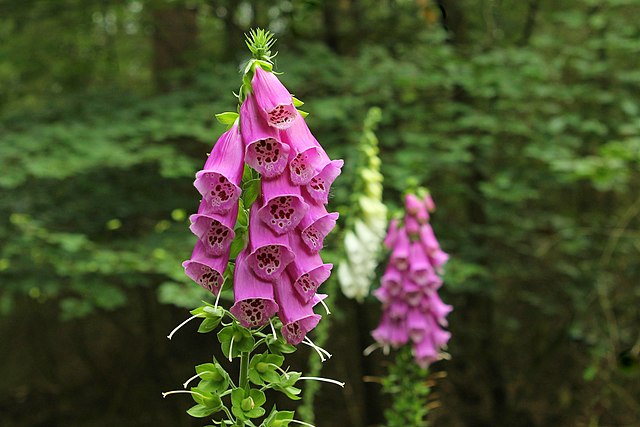
Image: Matthijs van den Berg CC BY-SA 4.0
A common plant that is popular in gardens due to it's striking spikes of pink and purple tubular flowers, the foxglove is native across the whole of the UK and can often be found on the edge of woodlands, roadside verges and hedgerows, as well as canal and river banks.
Often found in recently disturbed soil such as cleared woodland and scrub.
Life Cycle: Biennial
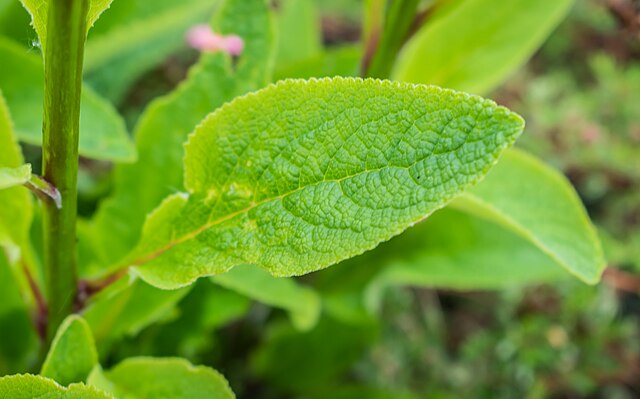
Image: Krzysztof Golik CC BY-SA 4.0
Appearance: Hairy, oval leaves with a toothed edge. Young plants may grow their leaves in a basal rosette, moving to alternately along the stem as they age.
Flowers are normally pink or purple and tubular, with darker spots on the lower part of the flower. These grow on large spikes which can reach two metres in height. Rarer pale pink to white variants can also be found, and these seem to be more common in more northern areas of the UK.
The flowers will appear mainly from June to August, but can extend into September in more northern or hilly areas and highlands.
The fruit of the foxglove is a capsule that changes from green to black as it ripens.
Toxicity: Contains the compounds Digitoxin and Digoxin, which can cause cardiac arrhythmia and low blood pressure. Other symptoms can include nausea, diarrhoea, headaches, and sensory disturbances such as halos and hallucinations.
The toxins are found in all parts of the plant.
More Info: https://www.woodlandtrust.org.uk/trees-woods-and-wildlife/plants/wild-flowers/foxglove/ (external link)
Deadly Nightshade (Atropa Belladonna)
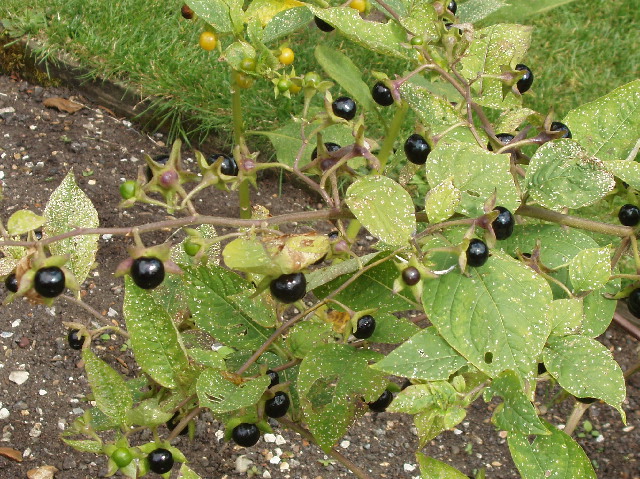
Image: David Hawgood - CC BY-SA 2.0
Found mainly in the southern half of the UK, can be found growing wild in woodlands, scrublands and recently disturbed soil. Prefers chalky or lime-rich soil and so can also be found on the edge of paths and banks.
Rare in the north of the UK, although occasionally remnants of previous plantings for medicinal or ornamental use can be found.
Life Cycle: Perennial
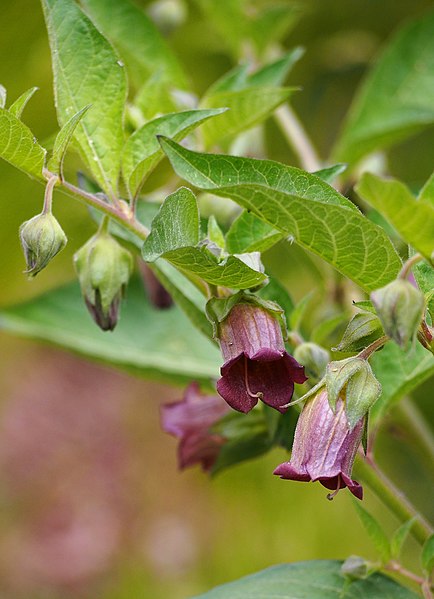
Image: Agnieszka Kwiecień - CC BY-SA 4.0
Appearance: A bushy perennial plant which can grow to heights of around 2 metres, with pale green, smooth-edged oval leaves with a pointed end. Leaves grow alternately on the stem and are strongly ribbed.
Bell shaped flowers consist of five fused petals which will normally be purple with brown to green colouration also present. They will be from 20-30mm in length.
Produces shiny green berries that turn black when fully ripe, and which have five visible sepals.
Toxicity: Present throughout the plant, but the berries are especially toxic. The plant contains multiple alkaloids which can induce a range of symptoms in the nervous system. The most well known is Atropine, the effects of which include sweating and nausea, but can also cause confusion, hallucinations, breathing difficulties, coma and death.
More Info: https://www.woodlandtrust.org.uk/trees-woods-and-wildlife/plants/wild-flowers/deadly-nightshade/ (external link)
Poison Hemlock (Conium Maculatum)
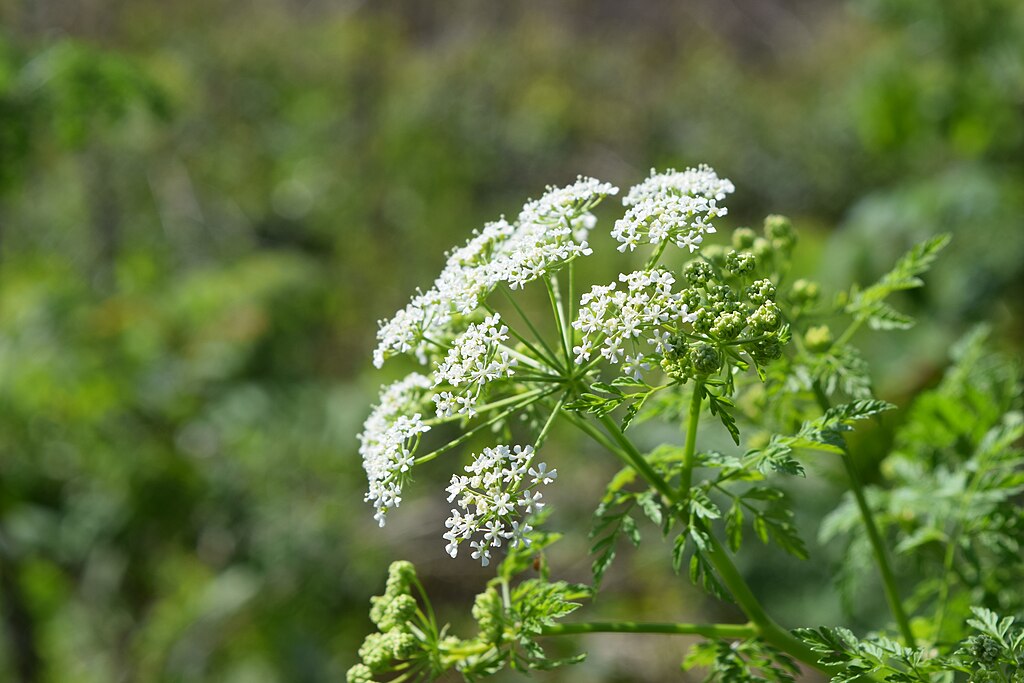
Image: Djtanng- CC SA 4.0 License
Widespread throughout the UK except for the far north. This large plant can grow up to two metres in height and is often mistaken for similar looking plants such as Cow Parsley or the Wild Carrot. It prefers to grow in damp ground, and so can be found on the edges of woodlands, along rivers and streams, ditches, roadside verges and wasteland.
Life cycle: Biennial
Appearance: Poison Hemlock grows up to two metres in height and can grow rapidly in the spring growing season. It has a smooth, hairless, hollow green stem that is spotted or streaked with red to purple. With finely divided, lacy pinnate leaves, which grow at the base in it's first non-flowering year.
The stems can become spotted with a deep maroon before turning brown and dying at the end of its biennial cycle. The stems can remain toxic for up to 3 years after dying.
Flowers are small, white and grow in umbrella shaped clusters. Each flower has five small petals. Hemlock will normally flower in June and July.
Often confused with the Wild Carrot (shorter with a solid, hairy stem; no purple markings and non-clustered flowers) and Cow parsley (striate purple markings and hair on stem).
Hemlock also has a distinct, unpleasant smell which has been likened to mouse urine.
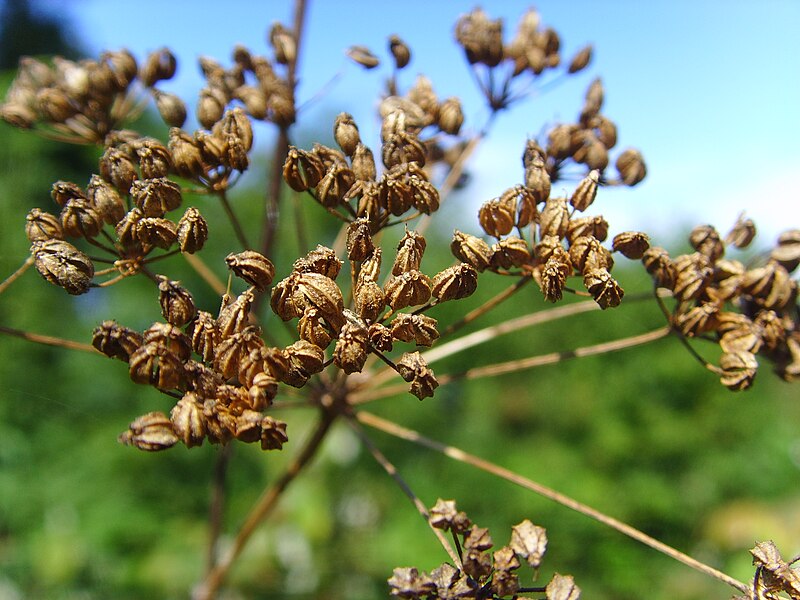
Image: Totnesmartin, Public domain
Toxicity: Like Deadly Nightshade, Hemlock contains multiple alkaloids which have multiple effects, but the main threat is Coniine which can cause paralysis and death through asphyxia. All parts of this plant are toxic and If ingested, even just a few small leaves can be fatal in humans. The seeds and roots are even more poisonous that the leaves and stem. It can also be poisonous from inhalation or skin contact. Extreme care should be taken when dealing with this plant, especially in the spring when it is at it's most toxic.
More Info: https://www.wildlifetrusts.org/wildlife-explorer/wildflowers/hemlock (external link)
Monkshood (Aconitum Napellus)
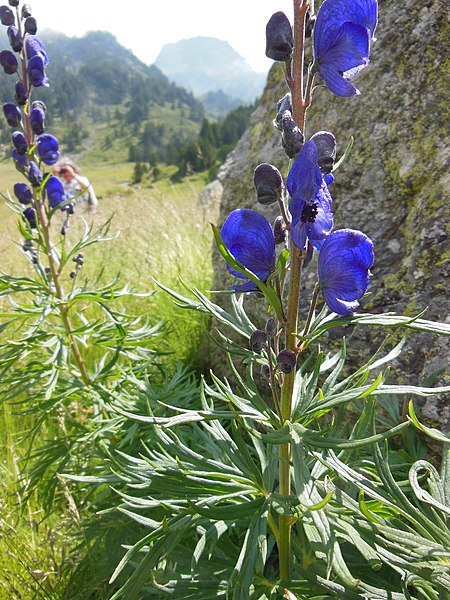
Image: Dominique Remaud CC BY-SA 2.0
Also known as Wolfsbane or Devil's Helmet, this plant is found throughout the UK, but is most common in the south, mainly in damp woodlands and meadows, and along streams and ditches. It is also popular as a garden plant and various cultivars can be found in many colours.
Historically, various species of Aconitum have been used across the world for poisoning spears and arrows for hunting and warfare.
Lifecycle: Perennial
Appearance: Dark green, deeply palmate leaves with 5-7 segments. Multi-petalled flowers with one petal elongated into a hood. The plant flowers on tall spike stems which can grow to over a metre in height.
Flowers are usually blue to deep purple in a distinctive helmet shape, although cultivars can be found with colours ranging to pink, white and yellow. The flowers are usually two to three centimetres in length and result in erect green, finger-like seed pods.
Flowering time is June to September.
Toxicity: Highly toxic in all parts of the plant, especially the root. It has been reported that the toxins can transfer through the skin so it is important to always wear gloves when dealing with this plant. Toxicity in this fashion can cause paraesthesia (tingling or burning sensation) in the hands and affected skin, and also headaches. Longer direct exposure may cause more severe effects.
When ingested, toxins can cause stomach aches, dizziness and heart problems in large enough doses. The plant tastes extremely unpleasant so such events are unusual.
More Info: https://www.woodlandtrust.org.uk/blog/2020/07/uk-poisonous-plants/ (external link)
Lords-and-ladies (Arum maculatum)
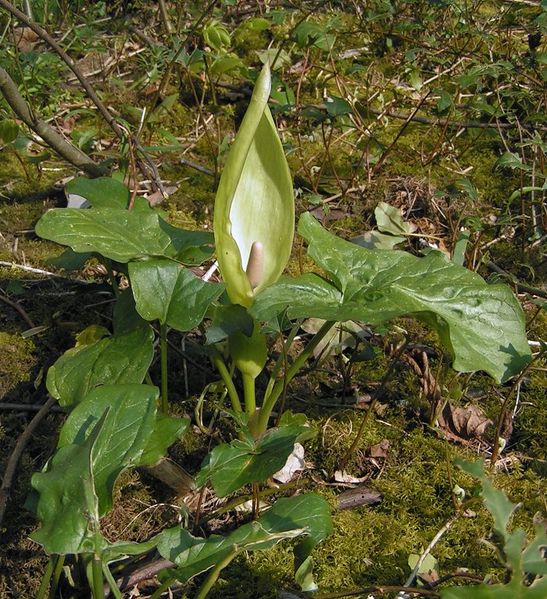
Image: wikicommons CC BY-SA 3.0
Also known as the Cuckoopint or Arum Lily, Lords-and-Ladies is most often found growing wild in woodland and in hedgerows throughout the UK and Europe, and has historically been cultivated as an ornamental. With it's distinctive hood shaped spathe and fetid smell it can be easily identified. When young, the leaves can resemble common sorrel, although the tail end of the leaves are more rounded than those of sorrel.
Lifecycle: Perennial
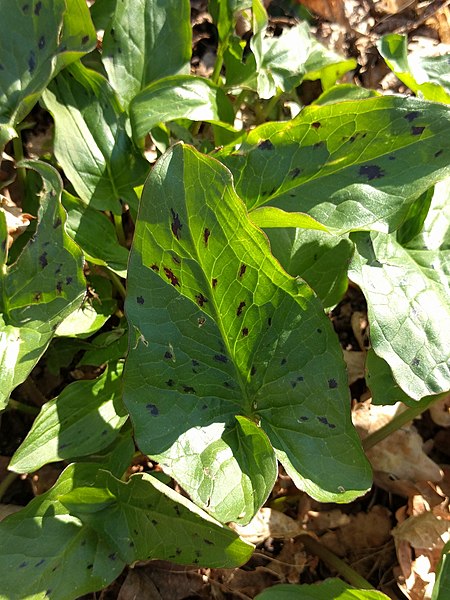
Image: Michel Langeveld CC BY-SA 4.0
Appearance: Large dark green arrow shaped leaves with dark purple to black spots which appear in the spring. The hooded, flower-like spathe appears in April or May and is generally pale or yellow-green.. The central, poker like spadix is in various shades from purple through to pale yellow.
When mature, the plant can reach 30-45cm in height and 25-20cm wide. It will spread quickly due to self seeding and has a deep tuberous root system that can be very difficult to remove when well established.
The berries of the Arum progress from green, through orange to red as they ripen, and they can remain after the rest of the plant has wilted.
The Arum is pollinated by flies, which it attracts by using a fetid smell, given off most strongly in the evening.
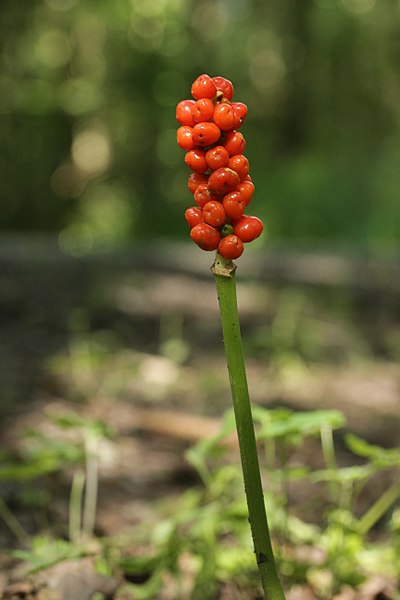
Image: Bjorn S CC BY-SA 2.0
Toxicity: All parts of the plant are toxic to humans (and all mammals), but the berries especially so. Skin contact can cause allergic reactions in many people.
The plant contains needle shaped oxalate crystals that can cause skin irritation on contact, and if ingested can cause the mouth, tongue and throat to swell; Cause breathing difficulties, stomach irritation and renal failure in large doses due to the irritation and swelling caused by these crystals. Thankfully the taste of the plant and it's berries is extremely acrid and thus such poisoning is rare due to the taste and the irritation caused on contact. There is no known antidote to the irritation caused by these crystals.
More info: https://www.woodlandtrust.org.uk/blog/2020/07/uk-poisonous-plants/ (external link)
Noxious/Injurious Weeds
Common Ragwort (Senecio jacobaea)
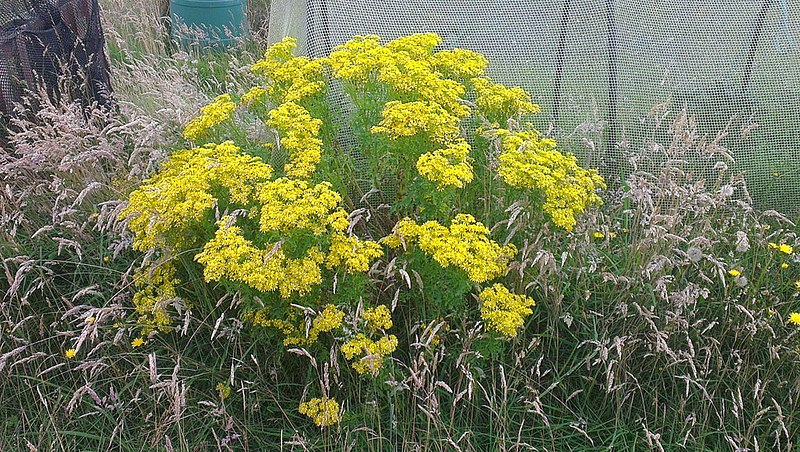
Image: Mike Pennington CC BY-SA 2.0
A plant native to the UK that is designated under the Weeds Act 1959 as an injurious weed. It commonly grows in paddocks, pastures, meadows, verges and wasteland. While the flowers are a good food source for many native insects such as butterflies, the chemicals within the plant can be dangerous to horses and so may need to be controlled in such areas.
Lifecycle: Biennial, flowering in the second year.
Appearance: Young plants appear from autumn through to early June as low rosettes of extremely variable leaves; either undivided, or very simply divided into oval terminals and small lateral lobes. Usually a deep bottle green, tinged with purple, and slightly glossy on the upper side.
Second year plants produce woody flowering stems from late June which can be between 30 and 100cm tall, with dense flat-topped clusters of yellow daisy like flowers. The mature leaves are strongly divided into narrow lobes.
Toxicity: Mainly of concern to horses and cattle, who can be poisoned from contaminated hay or feed. The various alkaloids contained in the plant can in large enough doses cause cirrhosis of the liver. Livestock are unlikely to eat the plant in its raw form, but when dried into feed or hay, it can be dangerous.
More Info: https://www.rhs.org.uk/weeds/ragwort (external link)
Broad-Leaved Dock (Rumex Obtusifolius) and Curled Leaf Dock (Rumex Crispus)
Broad-Leaved Dock (Rumex Obtusifolius)
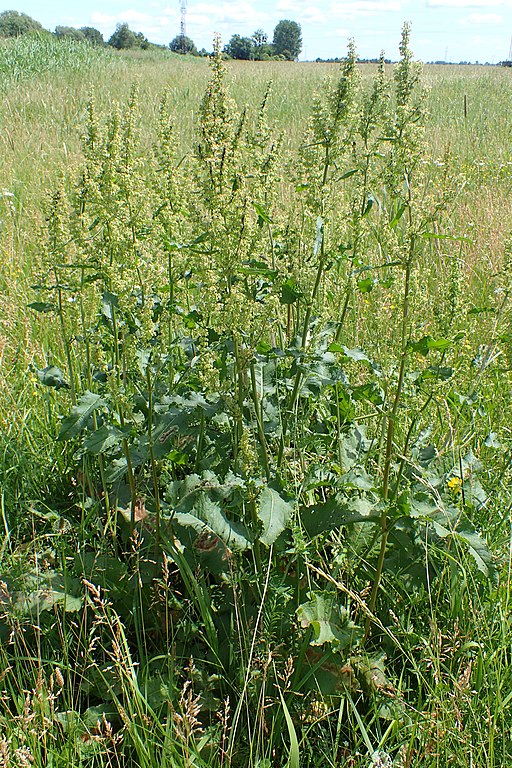
Image: Krzysztof Ziarnek CC BY-SA 4.0
Broad-leaved dock can be found throughout the UK, it is a native species commonly found on waste grounds, farmland, hedgerows, roadside verges, woodlands and gardens. It can form large, dense stands that outcompete other local species. They have a large taproot and can regrow from the top section. They can produce up to 60,000 seed per year which can lay dormant in the soil for decades, making eradication difficult.
Lifecycle: Perennial
Appearance: Young plants can emerge from September onwards, normally with an opposite pair of diamond or strap like leaves, which are then replaced with hearth shaped green leaves tinged with purple.
Adult plants produce a basal rosette of large, broad, oval to oblong leaves up to 25cm long with a strong central vein and rounded, backward pointing lobes at the base. Loosely branched flowering stems appear from late June and typically grow up to 80 to 100cm. Small greenish flowers turn reddish brown flowers as they mature and grow in clusters of racemes.
Concerns: The leaves contain oxalic acid, which can cause sickness in large amounts, both in humans and livestock. The Milky sap can also cause allergic reactions and mild dermatitis, but the main threat is from outcompeting other local species and forming dense tracts of plant that can take over the entire area if not kept under control.
Curled Leaf Dock (Rumex Crispus)
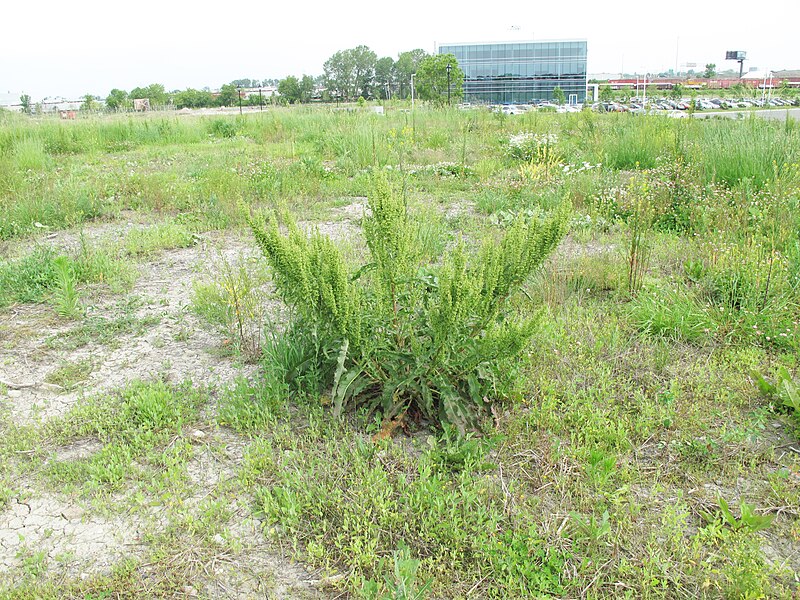
Image: Gilles Ayotte CC BY-SA 4.0
The Curled Leaf Dock is very similar to the Broad-Leaved dock, but can be identified by the fact that it's leaves are more tapering, with a wavy edge, and the flowering stems are often shorter, growing 60 to 100cm.
More Info: https://www.rhs.org.uk/weeds/docks (external link)
Creeping Thistle (Cirsium Arvense)
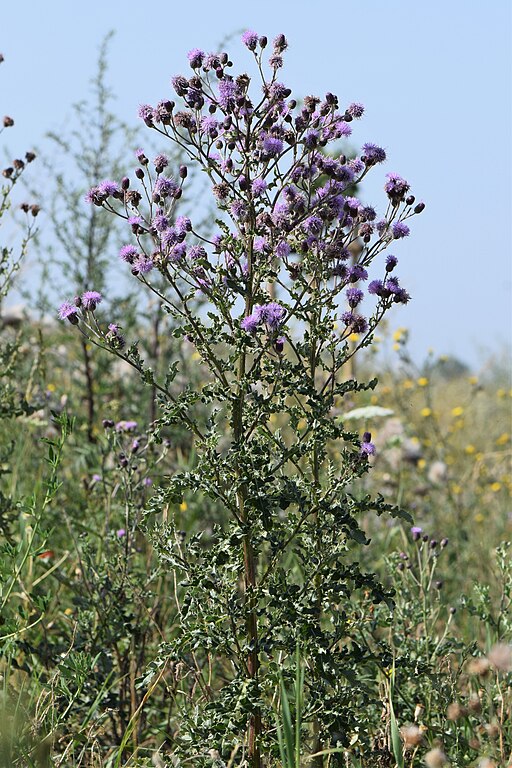
Image: Krzysztof Ziarnek CC BY-SA 4.0
Creeping Thistle is a perennial weed that can be found all over the UK ,and can be found on disturbed and cultivated ground, such as rough grassland, roadside verges and field edges from June to October. Creeping thistles can grow shoots from their weak lateral roots that will sprout shoots when broken, and can thus spread and establish dense colonies quickly.
Lifecycle: Perennial
Appearance: Immature plants tend to have small rosettes of wavey edge leaves with small, weak spines and small hairs on the upper surface. As the plant matures and it's root structer expands the leaves becoinme more elongated and narrow with strongly wavy and spined edges. Upper surfaces are glossy or waxy and the undersides are downy.
Flowering stems grow 30 to 100cm in height, are smooth and lack spines or ridges. Upon flowering, distinctive flower heads with lilac-pink florets on top of a small cylinder of spiny bracts grow in loose clusters, and these flowering heads turn into masses of fluffy wind-borne seeds in late summer.
Concerns: Non-Toxic. Thistles can be considered invasive, such is their propensity to spread quickly and overtake any particular location. Their colonies have been known to spread 6-12m in radius per year.
More Info: https://www.rhs.org.uk/plants/121159/cirsium-arvense/details (external link)
Spear Thistle (Cirsium Vulgare)
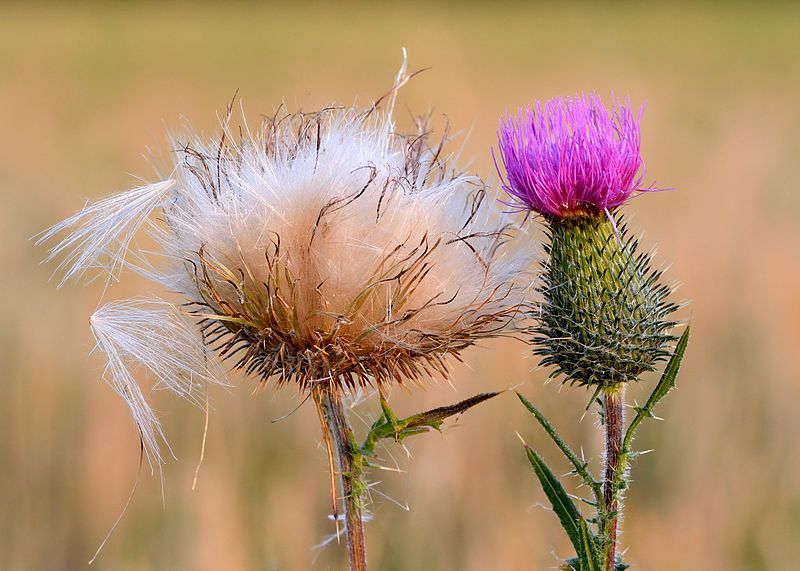
Image: Ivar Leidus CC BY-SA 4.0
The Spear Thistle is a biennial thistle that thrives in all the same places as its creeping cousin and can be found all over the UK, although is most likely to be found on wastelands and the edges of agricultural land and will often be one of the first species to colonise disturbed ground.
Lifecycle: Biennial (rarely 3-4 years)
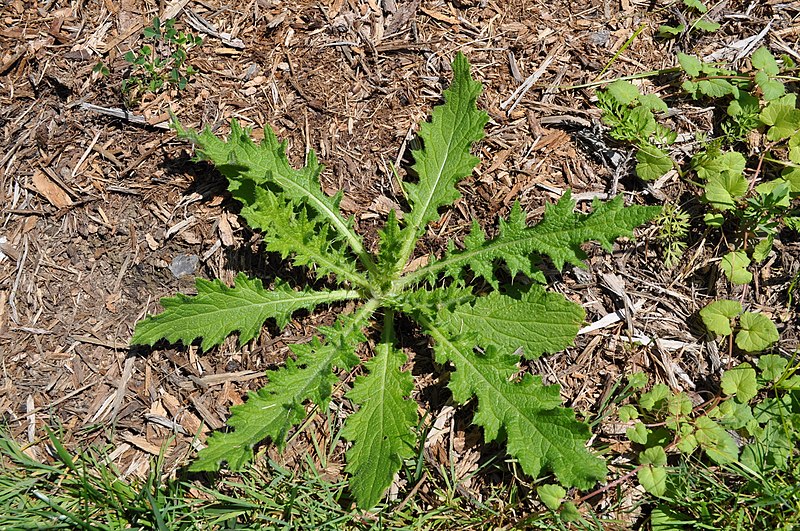
Image: Cornell University CC BY 2.0
Appearance: Appears from autumn through to the next April, as a basal rosette of leaves. These are spear shaped, deeply lobed and are covered in sharp spines. Up to 30cm long. From the centre of the rosette a flowering stalk emerges, which can be up to 1.5 metres tall. The leaves from this are spear shaped and much smaller. The stems themselves are cottony or hairy, with discontinuous wings which are lobed and spiny.
The flowers form a purple to mauve inflorescence that can be up to 5cm in diameter. Also distinctive are the bell shaped overlapping bracts found directly below the flowers.
Concerns: Non-Toxic. Thistles can be considered invasive, such is their propensity to spread quickly and overtake any particular location. Their colonies have been known to spread 6-12m in radius per year.
More Info: https://www.rhs.org.uk/plants/3847/cirsium-vulgare/details (external link)
Invasive Non-Native Species
Japanese Knotweed (Fallopia Japonica)
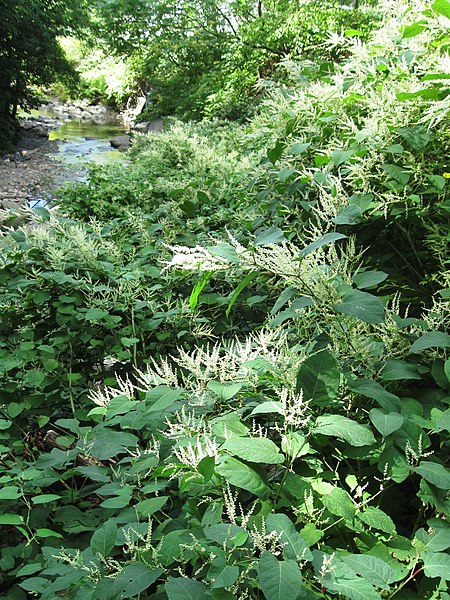
Image: Cbaile19 CC 0 1.0
Introduced to Europe in the early 19th century as an ornamental, this plant is now widespread across the UK. It outcompetes all local vegetation and grows into dense thickets, and is able to regrow even from tiny fragments of stem or extensive rhizome, thus spread is often exacerbated by eradication attempts. Listed under schedule 9 of the Wildlife and countryside act (external link), knotweed is also classified as a controlled waste and must be disposed of in a legally controlled manner to prevent it's spread.
Lifecycle: Perennial
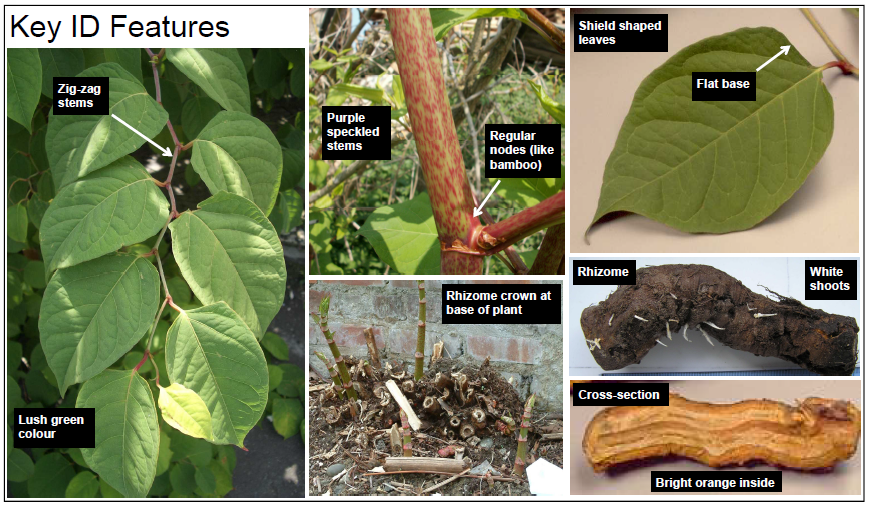
Appearance: Mature plants have flat-based, shield shaped leaves of a lush green colour, growing on zig-zag stems. The stem of the plant is hollow and has a characteristic red-green mottled appearance, which grows in regular sections like Bamboo from a crown at the base of the plant.
Stems can grow to 4m in height and spread aggressively.
Flowers are small and cream to white, and grow in erect racemes which can be from 6-15cm in late summer.
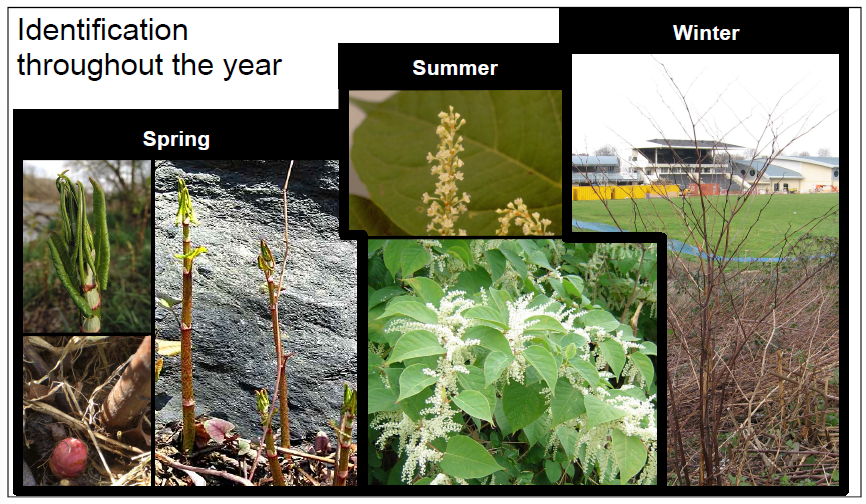
Concerns: Japanese Knotweed will outcompete everything in the vicinity and grow into vast dense thickets that are extremely difficult to control. It can take several years of treatment to remove an extablished patch of this plant.
It is also listed under Schedule 9 to the Wildlife and Countryside Act 1981 in England, Wales and Scotland. As such it is an offence to plant of otherwise cause Japanese knotweed to grow in the wild. Under the Environmental Protection Act 1990, Japanese Knotweed is classified as controlled waste and must be disposed of properly.
More Info: https://www.nonnativespecies.org/assets/Uploads/ID_Fallopia_japonica_Japanese_knotweed.pdf (external link, PDF)
Giant Hogweed (Heracleum mantegazzianum)

Image: Fritz Geller-Grimm CC BY-SA 3.0
Another invasive species introduced in the 19th century as an ornamental curiosity it has spread across the UK and is most commonly found on riverbanks where it can cause erosion and flooding. Easily identifiable, this member of the cow parsley family can be mistaken for other hogweeds when immature or stunted. Another species that will outcompete everything in the vicinity, it also causes health issues and so should be handled with care.
Lifecycle: Monocarpic Perennial. Usually 3-5 years before flowering.
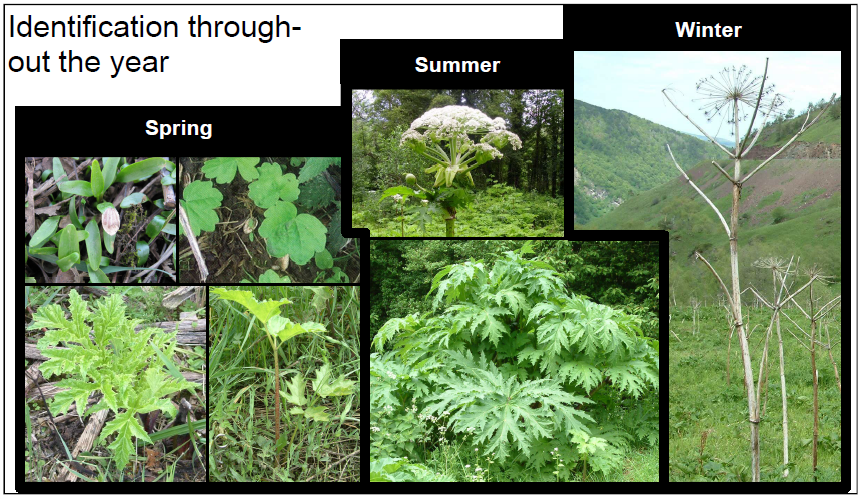
Appearance: When fully grown, it is unlikely to be mistaken for any other hogweed due to its sheer size. Can grow between 2.5 to 5m in height, with large umbrellas of white (occasionally pinkish) flowers measuring around 80cm across.
Basal leaves are sharply divided and can grow up to 3m across with bristles on the underside. Stems are blotched with purple and have sharp bristles, and the stem itself is often 5-10cm in diameter.
when in seed, the stem dies and the seed head can contain up to 50,000 seeds which will spread through wind dispersal and along watercourses when found by rivers.
Concerns: Giant Hogweed will outcompete any other local species and can cause river bank erosion and flooding. Also causes issues in urban areas as any trace of the weed must be removed before any development on affected land.
The Sap of this plant can also cause severe photosensitivity when it comes into contact with the skin, and so PPE should always be used when dealing with Giant Hogweed.
As with Japanese Knotweed, It is listed under Schedule 9 to the Wildlife and Countryside Act 1981 in England, Wales and Scotland. As such it is an offence to plant of otherwise cause it to grow in the wild. Under the Environmental Protection Act 1990, it is classified as controlled waste and must be disposed of properly.
More Info: https://www.nonnativespecies.org/assets/Uploads/ID_Heracleum_mantegazzianum_Giant_Hogweed-2.pdf (external link)
Himalayan Balsam (Impatiens Glandulifera)
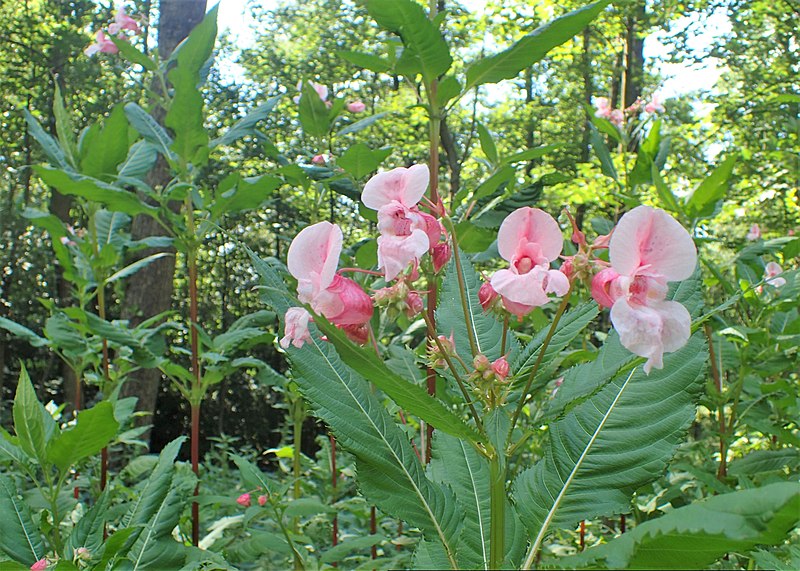
Image: Krzysztof Ziarnek CC BY-SA 4.0
Another ornamental that escaped into the wild int he 19th century, Himalayan Balsam has become a major pest. Preferring moist and semi-shaded places, waste ground, thin woodlands; but particularly on soft banks by slow-moving water along canal sides, streams and rivers. This plant will spread to create large monocultural stands that can drive off most other species.
Also often spread by gardeners sharing seeds and the resulting plant growing out of control.
Lifecycle: Annual. Some reports of dormancy of 2 years before germination.
Appearance: Germination in February to March, with shoots appearing and growing rapidly from April. Stout hollow stems that are reddish in appearance, growing up to 2.5m in height. Leaves grow opposite in whorls of three, 5-15cm in length, 3-8cm in width.
Flowering occurs in July to October, with deep purplish-pink to white flowers with a helmeted upper petal and a short spur. Early flowering examples can begin to seed from mid to late July. The plant displays explosive dehiscence, which can spread several hundred seeds up to 7m in all directions, and are easily carried by wind and water.
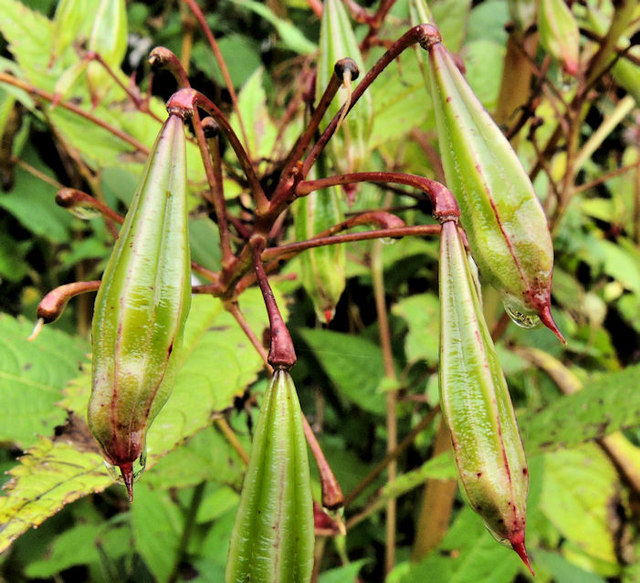
Image: Albert Bridge CC BY-SA 2.0
Concerns: Out-competes native species in ecologically sensitive areas, particularly river banks. Where it grows in dense stands along river banks it can impede flow at times of high rainfall, increasing the likelihood of flooding. Die back of extensive stands over winter can leave river banks bare and exposed to erosion..
Listed under Schedule 9 to the Wildlife and Countryside Act 1981 in England, Wales and Scotland. As such it is an offence to plant of otherwise cause it to grow in the wild. Unlike the previous two entries, is not classed as a controlled waste.
More Info: https://www.nonnativespecies.org/assets/Uploads/ID_Impatiens_glandulifera_Himalayan_Balsam-1.pdf (external link, PDF)
New Zealand Pygmyweed (Crassula Helmsii)
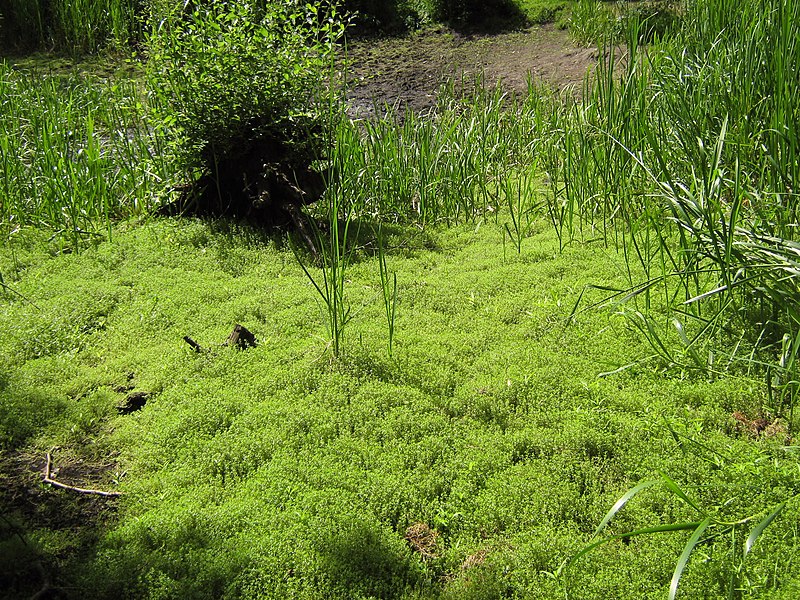
Image: Jonathan Kington CC BY-SA 2.0
New Zealand Pygmyweed is an invasive aquatic perennial that grows in ponds, lakes, reservoirs, canals and ditches as well as on damp mud on the margins of ponds and reservoirs. Introduced to the UK as an ‘Oxygenating plant’ for ponds in the early 20th century it was first recorded in the wild in 1856. It can completely cover smaller ponds, and will cover the margins of larger and deeper bodies of water over several square metres, and up to depths of 3m. Causes extensive decline in native plants and can cause a danger to wildlife due to its dense matting beneath the water level.
Lifecycle: Perennial
Appearance: Small fleshy succulent leaves which grow in opposite pairs up the stem, with bases joining to form a collar. Around 2cm in length. Under the water level, the leaves are more spread out and flattened and form dense matting.
Flowers maybe absent, but if present are small, whitish-green to slightly pink with 4 petals, growing on stems from the upper leaf axils.
It will regrow from small fragments of the plant and thus efforts to eradicate the plant can unintentionally disperse it further.
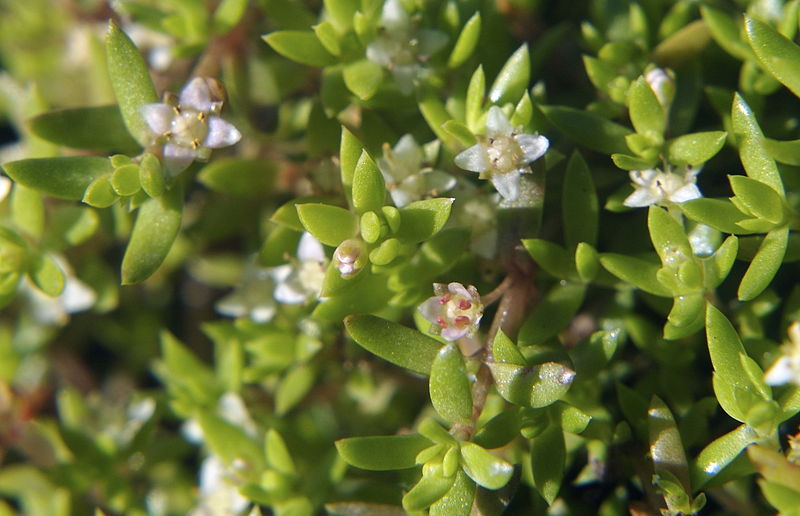
Image: Ashley Basil CC BY 2.0
Concerns: Dense matting underwater can cause danger to small wildlife. These mats also imped drainage and can cause flooding. Also reduces the utility and access to the water bodies.
Listed under Schedule 9 to the Wildlife and Countryside Act 1981 in England, Wales and Scotland. As such it is an offence to plant of otherwise cause it to grow in the wild. Banned for sale in the UK since 2014.
More Info: https://www.nonnativespecies.org/assets/Uploads/ID_Crassula_helmsii_New_Zealand_pigmyweed.pdf (external link, PDF)
Rhododendron (Rhododendron Ponticum)
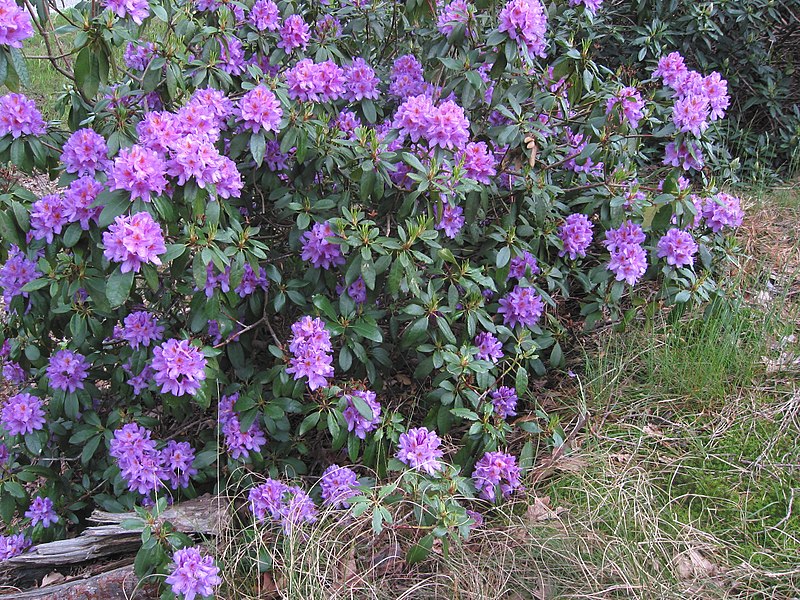
Image: Rasbak CC BY-SA 3.0
Introduced by gardeners in the 18th century from it's native range in the Iberian peninsula, it was planted in parks and woodlands and was also used to provide game cover in hunting grounds. Horticultural varieties remain popular but rarely are found in the wild. Often grows in ecologically sensitive habitats, such as heath, broad-leaved woodland and dunes, where dense growth can considerably alter the structure of the habitat.
Lifecycle: Evergreen Shrub
Appearance: A large evergreen shrub with leathery leaves, large purple flowers and solid stems that turn into a trunk when mature. Leaves are dull green on top and pale green underneath. Usually around 6-12cm in length. and grow in spirals at the end of the stems.
Multi-stemmed which grow into a trunk in more mature specimens, stems are thick, woody and up to 15cm in diameter.
Flowers are around 5cm across, grown in clusters and are usually pink or purple, but occasionally whiteish. After flowering, brown erect seed pods emerge containing large numbers of very small seeds which are easily dispersed by the wind.
Concerns: Once rhododendron has invaded an area, few native plants survive. In woodlands, only those trees which manage to grow above the level of the rhododendron canopy will persist. When such trees die, they cannot be replaced because seedlings cannot become established under the lightless canopy. At this point, the rhododendron completely dominates the area. Stands accumulate thick litter layers. Can also affect Oak, Beech and other immature native trees due to Phytophthora pathogens which are tolerated by the Rhododendron.
More Info: https://www.nonnativespecies.org/assets/Uploads/ID_Rhododendron_ponticum_Rhododendron.pdf (external link, PDF)
All images remain the property of the creators and are used under the CC licenses referenced under each image. No alterations have been made to the images.
